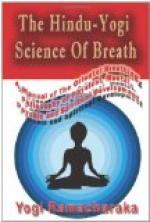(2) Mid breathing.
This method of respiration is known to Western students as Rib Breathing, or Inter-Costal Breathing, and while less objectionable than High Breathing, is far inferior to either Low Breathing or to the Yogi Complete Breath. In Mid Breathing the diaphragm is pushed upward, and the abdomen drawn in. The ribs are raised somewhat, and the chest is partially expanded. It is quite common among men who have made no study of the subject. As there are two better methods known, we give it only passing notice, and that principally to call your attention to its short-comings.
(3) Low breathing.
This form of respiration is far better than either of the two preceding forms: and of recent years many Western writers have extolled its merits, and have exploited it under the names of “Abdominal Breathing,” “Deep Breathing,” “Diaphragmatic Breathing,” etc., etc., and much good has been accomplished by the attention of the public having been directed to the subject, and many having been Induced to substitute it for the interior and injurious methods above alluded to. Many “systems” of breathing have been built around Low Breathing, and students have paid high prices to learn the new (?) systems. But, as we have said, much good has resulted, and after all the students who paid high prices to learn revamped old systems undoubtedly got their money’s worth if they were Induced to discard the old methods of High Breathing and Low Breathing.
Although many Western authorities write and speak of this method as the best known form of breathing, the Yogis know it to be but a part of a system which they have used for centuries and which they know as “The Complete Breath.” It must be admitted, however, that one must be acquainted with the principles of Low Breathing before he can grasp the idea of Complete Breathing.
Let us again consider the diaphragm. What is it? We have seen that it is the great partition muscle, which separates the chest and its contents from the abdomen and its contents. When at rest it presents a concave surface to the abdomen. That is, the diaphragm as viewed from the abdomen would seem like the sky as viewed from the earth—the interior of an arched surface. Consequently the side of the diaphragm toward the chest organs is like a protruding rounded surface—like a hill. When the diaphragm is brought into use the hill formation is lowered and the diaphragm presses upon the abdominal organs and forces out the abdomen.
In Low Breathing, the lungs are given freer play than in the methods already mentioned, and consequently more air is inhaled. This fact has led the majority of Western writers to speak and write of Low Breathing (which they call Abdominal Breathing) as the highest and best method known to science. But the Oriental Yogi has long known of a better method, and some few Western writers have also recognized this fact.




